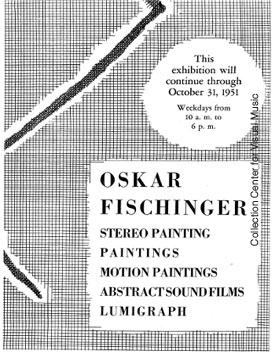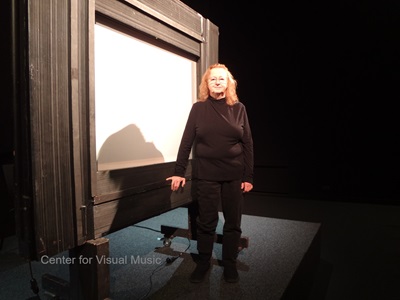
CVM's Oskar Fischinger pages: The Lumigraph
(under construction)
"The New Color-Play Instrument - A New Invention by Oskar Fischinger. The Instrument is played by HAND and produces the most fantastic color display - but controlled direct through the Player" - Oskar Fischinger
The Lumigraph is an analog Color-Play instrument, invented by Fischinger in the late 1940s. Music from LP records was used, there is no keyboard (it's not a 'color organ'). Two players were required, one to perform with hands on the screen, and the other to pull straps moving the 4 color wheels, changing colors (Oskar called these 'color control ropes'). Fischinger's daughter Barbara (below left with original Lumigraph) assisted him over several decades, and has explained the Lumigraph in documentary footage shot by CVM, and an interview with Cindy Keefer in CVM's recent Fischinger monograph (see Bibliography below). In the photo below right, the front panels are opened revealing the color wheels with colored filters (4 basic colors). Lighting tubes here are not original, the originals were light bulbs or floods.

There are no films or recordings of any of Oskar's performances. He performed the Lumigraph at San Francisco Museum of Art (1953), The Coronet Theatre, Los Angeles; Frank Perls Gallery, Beverly Hills (1951), and often at his home studio for visitors. The image above, top, is from a flyer from the Frank Perls Gallery exhibition. Programs and flyers from these performances are in the library of Center for Visual Music in Los Angeles. There are 16mm films of Elfriede's performances, after Oskar's death. One of the Lumigraph films made by her was preserved by CVM and featured in the 2005 "Visual Music" exhibition at The Hirshhorn Museum and MOCA LA (stills at bottom).
The name Lumigraph was first used by and patented by Oskar. The modified instrument used in the Time Travelers film was called a Lumichord. The producers modified a later Lumigraph, adding a keyboard, and had the performer play from the front.
Excerpt below from one of the Lumigraph Films (c. 1969, 16mm, color), film of a performance of Oskar's Lumigraph, by Elfriede Fischinger (with the assistance of Wiliam Moritz and Conrad Fischinger) in Los Angeles. Due to film stocks' low light speeds at that time, she undercranked the camera thus the footage is too fast when projected. This excerpt was filmed silent; Elfriede often performed to "Valse Triste."
Lumigraph Film (c. 1969) by Elfriede Fischinger (excerpt) from CVM on Vimeo.
Elfriede shows the Lumigraph frame, without its screen, at The Louvre, Paris, 1996.
This is the original Lumigraph. Photographer unknown.
Elfriede and Barbara Fischinger, and William Moritz, after a Lumigraph performance at Goethe Institut Los Angeles, c. 1995.
This is one of the later Lumigraphs.
William Moritz wrote about The Lumigraph in "The Dream of Color Music, and Machines That Made it Possible" in Animation World Magazine, Los Angeles, 1997.
In the late 1940s, when Fischinger had lost the support of the Guggenheim Foundation, he also invented a color organ instrument that allowed one to play lights to any music very simply. His Lumigraph hides the lighting elements in a large frame, from which only a thin slit emits light. In a darkened room (with a black background) you can not see anything except when something moves into the thin "sheet" of light, so, by moving a finger-tip around in a circle in this light field, you can trace a colored circle (colored filters can be selected and changed by the performer). Any object can be used: a gloved hand, a drum-stick, a pot-lid (for a solid circle), a child's block (for a square), etc. Oskar performed certain compositions (such as Sibelius' "Valse Triste") publicly, at the Coronet Theater in Los Angeles, and at the San Francisco Museum of Art in 1953, in connection with a one-man show of his abstract oil paintings (where Jordan Belson saw it, and was greatly impressed by the mysterious "presence" of its color).
Fischinger hoped, like Castel long before, that someone would manufacture Lumigraphs, and that they would become common household items, used by children for play and artistic training, by adults for recreation and party games. Although that has not yet occurred, Oskar's original Lumigraph does survive, in the Deutsches Filmmuseum in Frankfurt, where it is played with some regularity, and it has been loaned to the Louvre in Paris and the Gemeente Museum in the Hague for performances by Oskar's widow Elfriede. Oskar's son Conrad also constructed two other Lumigraphs, one large one that was used on an Andy Williams television special [1], and a smaller one to use in Los Angeles performances. The Lumigraph also appeared in a 1964 science-fiction movie The Time Travelers, in which it is a "love machine" that allows people to vent their sexual urges in a harmless sensuality. (END)
CVM Notes: Only Elfriede used an object to play the Lumigraph; neither Oskar nor Barbara, his daughter whom he trained on the Lumigraph and performed as his partner, used an object. They considered Elfriede's playing with an object as not correct.
[1] Barbara Fischinger confirmed the Lumigraph was not ready in time and was not used for an Andy Williams special. Neither Oskar or any of his family performed the Lumigraph for the Time Travelers film. Oskar never saw the footage used in the film, and his family made sure he never read any reviews or saw ads, realiizing how upset he'd be with its usage as a "love machine."
Poster for Hollywood feature film, advertising the "Love Machine." Collection Center for Visual Music
Image from a Lumigraph performance
BIBLIOGRAPHY (also see Elfriede's and Moritz's articles above)
Fischinger, Elfriede. "Writing Light" First printed in Fischinger: A Retrospective of Paintings and Films exhibition catalog (Denver, CO: Gallery 609, 1980). Reprinted in The Relay. 3.2 (May 1984): 4-7. Reprinted in First Light, Robert A. Haller, ed. New York: Anthology Film Archives, 1998: 30-34.
James, David. The Most Typical Avant-Garde: History and Geography of Minor Cinemas in Los Angeles. Berkeley: University of California Press, 2005.
Keefer, Cindy. The Lumigraph: Dancing With Your Hands. An Interview with Barbara Fischinger, in Oskar Fischinger (1900-1967), Experiments in Cinematic Abstraction. Keefer, Cindy and J. Guldemond, eds. Amsterdam and Los Angeles: EYE Filmmuseum and Center for Visual Music, 2012. Distributed by Thames & Hudson. This interview is the most thorough account of the Lumigraph published to date.
---Jordan Belson, Cosmic Cinema and the San Francisco Museum of Art. SF MoMA Open Space, Blog post October 2010.
---'Raumlichtmusik' - Early 20th Century Abstract Cinema Immersive Environments Leonardo Electronic Almanac Vol 16, no.6-7 . Leonardo, Journal of the International Society for the Arts, Sciences and Technology. October 2009. PDF.Melchior, Ib. Six Cult Films from The Sixties. BearManor Media, 2009.
Moritz, William. Optical Poetry: The Life and Work of Oskar Fischinger. Eastleigh: John Libbey, and Indiana University Press, 2004.
---"The Dream of Color Music, and Machines That Made it Possible" in Animation World Magazine, Los Angeles, 1997 (contains errata)
--- "The Dream of Color Music" in The Spiritual in Art: Abstract Painting 1890-1985, ed. Maurice Tuchman. Abbeville, 1993.Peacock, Kenneth. "Instruments to perform color-music: Two centuries of technological experimentation," Leonardo, 21 (1988).
Snibbe, Scott. Dreams of Abstract Mass Media. Blog Post, October 2010
Snibbe, Scott. Interactive Dynamic Abstraction. Published in the Proceedings of Non-photorealistic Animation and Rendering (NPAR 2000). Annecy, France. © 2000 ACM
OTHER MATERIALS
Fischinger's Patent for The Lumigraph, granted 1955 - "Device for Producing Light Effects"
Video demonstration and interview, Barbara Fischinger (Oskar's daughter) demonstrations the Lumigraph during a rehearsal, and reminisces about playing it with her father. This material is being edited by CVM for a future documentary. An excerpt can be seen in the Color in Motion exhibition in Los Angeles, October 2024-July 2025.
Fischinger Master Class. CVM's Master Class on Oskar Fischinger is held twice a year, via zoom. Fischinger historian Cindy Keefer covers his career and films, including an in-depth look at the Lumigraph, and screening rarely seen films. Inquire for info or to register for the next sessions (CVM email at bottom of page). 5 weekly sessions, Thursdays 11am PST, $200.
Program notes (PDF) from "A Tribute to Oskar Fischinger - Film program and Lumigraph Presentation" at Deutsches Filmmuseum, Frankfurt, with Barbara Fischinger and Cindy Keefer. 2007.
Testimonial by Jordan Belson about Fischinger and the Lumigraph, from series of Fischinger Testimonials collected by William Moritz. Published in Moritz's Optical Poetry: The Life and Work of Oskar Fischinger. Eastleigh: John Libbey, and Indiana University Press, 2004.
(
Return to CVM main Fischinger page
Help Support the Preservation of your Favorite Fischinger Film
Contact us: cvmaccess (at) gmail (dot) com
Unless noted, text and images on these Fischinger pages are copyright 2021 Center for Visual Music, and are protected by copyright laws (incl. Title 17 U.S. Code). Please seek permission before reproducing any of this material. Contact cvmaccess (at) gmail.com
Time Travelers poster is not copyright CVM.